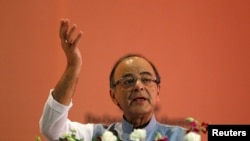More than a decade after it was proposed, India’s most ambitious tax reform measure is set to roll out in six weeks following the passage of a law that will replace a plethora of confusing levies with a single, nationwide tax.
The new goods and services tax (GST) will unite the world’s fastest growing economy into a common market of 1.3 billion people.
The measure is seen as a major achievement for Prime Minister Narendra Modi, who struggled for two years to build a political consensus.
The government says the GST will be implemented from July 1 after state legislatures ratify it.
The new tax is expected to make it vastly easier to do business as it dismantles tax checkpoints at every state border. Businesses have often complained that India’s complicated tax system leaves them grappling with a mesh of separate duties levied by each of the country’s 29 states, and goods are often stranded for hours or even days at state borders as payments are worked out.
By making distribution more efficient and less expensive, Ankur Bisen at New Delhi based consultancy, Technopak, sees big benefits for consumer-oriented businesses, which have to move goods across state lines in the vast country.
Another huge benefit will be increased transparency. “It will have implications on corruption because taxation regime will not be vague anymore, it will be very clearly defined,” says Bisen.
For the government, the GST is expected to improve tax compliance and draw more people into the tax net in a country where tax evasion is common. It will also make India more attractive for foreign investors by simplifying rules for a huge and increasingly attractive market.
The government estimates the new tax will boost economic growth by about half a percentage point in its first year of implementation and in the long run by as much as 2 percent.
However several economists say that the political compromises that had to be struck win approval of the new tax mean the sweeping benefits India had hoped to see may not accrue in the short run.
Taxes will be levied at four levels – five, 12, 18 and 28 percent. Many say the 18 percent and 28 percent tax rates are too high.
“It could potentially have been a transformative measure if the structure of GST would have been characterized by a large base and low and single rate,” says D.K. Srivastava at consultancy Ernst and Young. But, he says, “it is going as a multiple-rate system and some of the rates are very high and the tax base is still narrow. Therefore it is a kind of a fragmented GST. ”
Despite the shortfalls, Srivastava says that “given the complications of the size of the Indian economy, it might be useful to start off with a functioning model and then go on reforming it as matters progress.”
Many also warn against a hasty implementation, saying that rushing ahead with a July 1 deadline could make it difficult to handle the transition in a country which has always struggled with bureaucratic ineptitude.
Many businesses, which had long clamored for such a tax, are asking the government for more time to prepare for the switch, saying six weeks is too little. They worry that the tax rates for various products have still be to be decided.
Others point out that the GST will be serviced by state-of-the-art technology and an electronic portal where taxpayers can register, eliminating the conventional and discretionary role of tax authorities.






